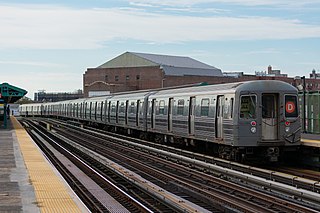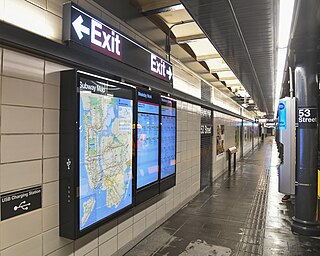
The R32 was a New York City Subway car model built by the Budd Company from 1964 to 1965 for the IND/BMT B Division. A total of 600 R32s were built, numbered 3350–3949, though some cars were re-numbered. The R32 contract was divided into two subcontracts of 300 cars each: R32 and R32A ; the former was paid by the city's capital budget and the latter was paid through a revenue bond. All were arranged as married pairs.

The R142A is the second order of new technology cars (NTTs) for the A Division of the New York City Subway. These cars were built by Kawasaki Heavy Industries in Japan at Kobe, Hyōgo and Lincoln, Nebraska U.S. with final assembly performed at Yonkers, New York. They replaced the Redbird trains, including the R26, R28, R29, R33, R33S, and R36. The R142A fleet initially comprised 600 cars, arranged as five-car units.

The R44 is a New York City Subway car model built by the St. Louis Car Company from 1971 to 1973 for the B Division and the Staten Island Railway (SIR). The cars replaced many R1–9 series cars, and all remaining 1925 Standard Steel built SIRTOA ME-1 trains, providing Staten Island with a new fleet of railcars. The R44 fleet originally consisted of 352 cars, of which 56 remain in service, all on the Staten Island Railway.

The R62 is a New York City Subway car model built between 1983 and 1985 by Kawasaki Heavy Industries in Kobe, Japan, for the A Division. A total of 325 cars were built, originally as single units. When the reliability of the fleet improved, they were converted to five-car sets. The cars replaced the remaining R12s, R14s, and R15s, which were all retired by the end of 1984.

The New York City Subway is a large rapid transit system and has a large fleet of electric multiple unit rolling stock. As of September 2024, the New York City Subway has 6712 cars on the roster.

The R33S was a New York City Subway car that was built by St. Louis Car Company in 1963 for the IRT A Division. They were purchased for service on the IRT Flushing Line, which was the closest line to the 1964 New York World's Fair. A total of 40 cars were built, arranged as single cars. While in regular service, each R33S was coupled to five two-car consists of R36 cars to make 11-car trains for the 7 and <7> routes.

The R68A is a B Division New York City Subway car order consisting of 200 cars built between 1988 and 1989 by Kawasaki Railcar Company in Kobe, Japan, with final assembly done at the Kawasaki plant in Yonkers, New York. A total of 200 cars were built, arranged in four-car sets.

The R110B was a prototype class of experimental New Technology Train (NTT) New York City Subway cars built by Bombardier of Canada for service on the B Division services. There were nine cars, arranged as three-car sets. They were designed to test features that would be implemented on future mass-production NTT orders.

The R110A was a New York City Subway car model built by Kawasaki Heavy Industries in 1992 as a prototype New Technology Train to test various technologies. There were ten cars arranged as five-car sets. They were designed to test features that would be implemented on future mass-production New Tech Train orders.

The R68 is a B Division New York City Subway car order consisting of 425 cars built by the Westinghouse-Amrail Company, a joint venture of Westinghouse, ANF Industrie, Jeumont Schneider, and Alsthom. The cars were built in France from 1986 to 1988 and shipped through New York Harbor. Of the cars in the fleet, 416 are arranged in four-car sets while the other nine are single cars.

The R143 is a class of New Technology Train subway cars built by Kawasaki Rail Car Company for the New York City Subway's B Division. Delivered between 2001 and 2003, the cars displaced R40s and R42s that operated on the L service in conjunction with the BMT Canarsie Line's signal system being automated.

The R160 is a class of New Technology Train subway cars built for the New York City Subway's B Division. Entering service between 2006 and 2010, they replaced all R38, R40, and NYCT-operated R44 cars, and most R32 and R42 cars. The R160s are very similar to the earlier R143s and later R179s. The biggest difference between the R160 and R143 is the Flexible Information and Notice Display (FIND) system on the R160s in place of static LED maps on the R143s and all A-Division New Technology fleet.

The R179 is a class of 318 New Technology Train subway cars built by Bombardier Transportation for the New York City Subway's B Division. Entering service between 2017 and 2020, the cars replaced all remaining R32s and R42s.

The R188 is a class of new technology (NTT) New York City Subway cars built by Kawasaki Heavy Industries for the A Division. The fleet entered service in 2013, displacing the mid-1980s–era R62A cars that operated on the 7 and <7> services, in conjunction with the automation of the IRT Flushing Line's signal system with communications-based train control (CBTC). The R188 order also expanded the 7's fleet as part of the 7 Subway Extension, which opened in 2015.

The R211 is a class of New Technology Train (NTT) subway cars built for the New York City Transit Authority. Being built by Kawasaki Railcar Manufacturing for the B Division of the New York City Subway and for the Staten Island Railway (SIR), they will replace two aging subway car models: all R44 cars on the SIR, plus all R46 and some R68 subway cars. The order is split into three parts: R211A and R211T cars for the subway and R211S cars for the SIR. The R211Ts employ open gangways between cars, allowing passengers to see and walk through the entire length of the train – a feature not present on the subway's other rolling stock.

New Technology Train (NTT) is the collective term for the modern passenger fleet of the New York City Subway that has entered service since the turn of the 21st century. This includes the current R142, R142A, R143, R160, R179, R188 and R211 models, along with the planned R262 and R268 models. Two prototypes, the R110A and R110B, were used to test the features that would be found on all NTT trains today.

Since the late 20th century, the Metropolitan Transportation Authority has started several projects to maintain and improve the New York City Subway. Some of these projects, such as subway line automation, proposed platform screen doors, the FASTRACK maintenance program, and infrastructural improvements proposed in 2015–2019 Capital Program, contribute toward improving the system's efficiency. Others, such as train-arrival "countdown clocks", "Help Point" station intercoms, "On the Go! Travel Station" passenger kiosks, wireless and cellular network connections in stations, MetroCard fare payment alternatives, and digital ads, are meant to benefit individual passengers. Yet others, including the various methods of subway construction, do not directly impact the passenger interface, but are used to make subway operations efficient.

The R262 is a proposed New Technology Train-series subway car for the New York City Subway. It is expected to replace the current R62 and R62A rolling stock, which are used on the subway's A Division and were built in the mid-1980s.






















